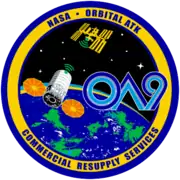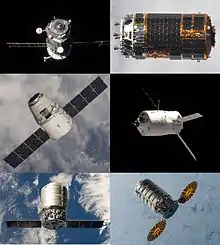_(cropped).jpg.webp) Canadarm2 grapples the S.S. J.R. Thompson | |
| Mission type | ISS logistics |
|---|---|
| Operator |
|
| COSPAR ID | 2018-046A |
| SATCAT no. | 43474 |
| Mission duration | 70 days, 32 minutes |
| Spacecraft properties | |
| Spacecraft | S.S. J.R. Thompson |
| Spacecraft type | Enhanced Cygnus[1][2] |
| Manufacturer |
|
| Launch mass | 6,172 kg (13,607 lb)[3] |
| Start of mission | |
| Launch date | 21 May 2018, 08:44:06 UTC[4] |
| Rocket | Antares 230[2][5][6] |
| Launch site | Wallops Pad 0A |
| Contractor | Orbital ATK |
| End of mission | |
| Disposal | Deorbited |
| Decay date | 30 July 2018, 09:17 UTC[7] |
| Orbital parameters | |
| Reference system | Geocentric orbit |
| Regime | Low Earth orbit |
| Inclination | 51.66° |
| Berthing at the International Space Station | |
| Berthing port | Unity nadir |
| RMS capture | 24 May 2018, 09:26 UTC[8] |
| Berthing date | 24 May 2018, 12:13 UTC |
| Unberthing date | 15 July 2018, 10:20 UTC |
| RMS release | 15 July 2018, 12:37 UTC[9] |
| Time berthed | 52 days, 54 minutes |
| Cargo | |
| Mass | 3,350 kg (7,390 lb)[10] |
| Pressurised | 3,268 kg (7,205 lb) |
| Unpressurised | 82 kg (181 lb) |
 NASA insignia | |
OA-9E was the tenth flight of the Orbital ATK uncrewed resupply spacecraft Cygnus and its ninth flight to the International Space Station (ISS) under the Commercial Resupply Services (CRS contract) with NASA.[11][12] The mission launched on 21 May 2018 at 08:44:06 UTC. Orbital ATK and NASA jointly developed a new space transportation system to provide commercial cargo resupply services to the International Space Station. Under the Commercial Orbital Transportation Services (COTS) program, then Orbital Sciences designed and built Antares, a medium-class launch vehicle; Cygnus, an advanced maneuvering spacecraft, and a Pressurized Cargo Module which is provided by Orbital's industrial partner Thales Alenia Space.[13]
History
.jpg.webp)
The COTS demonstration mission was successfully conducted in September 2013, and Orbital commenced operational ISS cargo missions under the Commercial Resupply Service (CRS) program with two missions in 2014. Regrettably, the third operational mission, Orb CRS-3, resulted was not successful due to spectacular Antares failure during launch. The company decided to discontinue the Antares 100 series and accelerate the introduction of a new propulsion. The Antares system will be upgraded with newly built RD-181 first-stage engines to provide greater payload performance and increased reliability.[5]
In the meantime, the company had contracted with United Launch Alliance for an Atlas V launch of CRS OA-4 in late 2015 from Cape Canaveral, Florida, with a second Atlas V Cygnus launch in 2016.[5][6] The company had planned Cygnus missions for the first (CRS OA-5), second (CRS OA-6) and fourth quarters (CRS OA-7) of 2016. Two of which flew on the new Antares 230 and one on the aforementioned second Atlas V. These three missions enabled Orbital ATK to cover their initial CRS contracted payload obligation.[6][14] This particular mission, known as CRS OA-9E, is part of an extension program that will enable NASA to cover the ISS resupply needs until the Commercial Resupply Services-2 (CRS-2 contract) enters in effect, and thus the "E" indicates that it actually is an extension above the originally contracted payload transport.[14]
Production and integration of Cygnus spacecraft is performed in Dulles, Virginia. The Cygnus service module is mated with the pressurized cargo module at the launch site, and mission operations are conducted from control centers in Dulles, Virginia and Houston, Texas.[13]
Spacecraft
This is the ninth of ten flights by Orbital ATK under the Commercial Resupply Services contract with NASA, and it is considered an extension over the originally contracted flights. This is the sixth flight of the Enhanced sized Cygnus PCM.[6] The mission launched on 21 May 2018.[15][16]
In an Orbital ATK tradition, this Cygnus spacecraft was named the S.S. J.R. Thompson after the former president and chief executive officer at Orbital Sciences Corp. who died in 2017. Thompson served in multiple management positions at Orbital, overseeing development of the Antares rocket and other vehicles in the company's launcher family.[17]
Manifest
.jpg.webp)
NASA contracted for the CRS OA-9E mission from Orbital ATK and therefore determined the primary payload, date/time of launch, and orbital parameters for the Cygnus space capsule. CRS OA-9E carried a total of 3,350 kg (7,390 lb) of material into orbit. This includes 3,268 kg (7,205 lb) of pressurised cargo with packaging bound for the International Space Station, and 82 kg (181 lb) of unpressurised cargo. The unpressurised cargo consists of a Nanoracks deployer and six CubeSats which will be released after Cygnus unberths from the ISS.
The following is a breakdown of cargo bound for the ISS:[10]
- Crew supplies: 811 kg (1,788 lb)
- Science investigations: 1,021 kg (2,251 lb)
- Spacewalk equipment: 132 kg (291 lb)
- Vehicle hardware: 1,192 kg (2,628 lb)
- Computer resources: 100 kg (220 lb)
- Russian hardware: 13 kg (29 lb)
- Nanoracks CubeSat Deployer: 82 kg (181 lb)
ISS Reboost Test
Several days before unberthing operations were underway, a unique task was performed by Cygnus—a test of the spacecraft’s reboost capability. It was the first time a commercial vehicle performed this task, which is typically handled by Russian Progress spacecraft.
At 4:25 p.m. EDT (20:25 GMT) July 10, Cygnus’s main engine was fired for about 50 seconds. Although it was just a brief reboost test, it still raised the altitude of about 295 feet, according to NASA.[18]
See also
References
- ↑ Bergin, Chris (22 February 2012). "Space industry giants Orbital upbeat ahead of Antares debut". NASASpaceflight.com. Retrieved 29 March 2012.
- 1 2 "Orbital ATK Team on Track for Fall 2015 Cygnus Mission and Antares Return to Flight in 2016". Orbital ATK. 12 August 2015. Retrieved 12 August 2015.
- ↑ "Cygnus OA-9 Mission: Fact Sheet" (PDF). Orbital ATK. 2018. Archived from the original (PDF) on 24 May 2018. Retrieved 23 May 2018.
- ↑ Clark, Stephen (21 May 2018). "Antares rocket launch kicks off space station's next commercial cargo delivery". Spaceflight Now. Retrieved 23 May 2018.
- 1 2 3 Gebhardt, Chris (14 August 2015). "Orbital ATK make progress toward Return To Flight of Antares rocket". NASASpaceflight.com. Retrieved 14 August 2015.
- 1 2 3 4 Leone, Dan (17 August 2015). "NASA Orders Two More ISS Cargo Missions From Orbital ATK". SpaceNews. Retrieved 17 August 2015.
- ↑ Cox, Vicki (30 July 2018). "Northrop Grumman's Cygnus Spacecraft Successfully Concludes Ninth Cargo Supply Mission to the International Space Station" (Press release). Northrop Grumman. Retrieved 6 August 2018.
- ↑ Richardson, Derek (24 May 2018). "OA-9 Cygnus Cargo Ship Arrives at ISS". Spaceflight Insider. Retrieved 25 May 2018.
- ↑ Richardson, Derek (15 July 2018). "Northrop Grumman's OA-9 Cygnus leaves International Space Station". Spaceflight Insider. Retrieved 6 August 2018.
- 1 2 "Overview: Orbital ATK CRS-9 Mission" (PDF). NASA. 2018. Retrieved 23 May 2018.
 This article incorporates text from this source, which is in the public domain.
This article incorporates text from this source, which is in the public domain. - ↑ "Worldwide launch schedule". Spaceflight Now. Retrieved 12 February 2015.
- ↑ "International Space Station Flight Schedule". Students for the Exploration and Development of Space. 15 May 2013.
- 1 2 "Cygnus Fact Sheet" (PDF). Orbital ATK. 24 March 2015. Archived from the original (PDF) on 26 September 2015. Retrieved 14 August 2015.
- 1 2 Leone, Dan (20 August 2015). "NASA Considering More Cargo Orders from Orbital ATK, SpaceX". SpaceNews. Retrieved 20 August 2015.
- ↑ "Launch Schedule". Spaceflight Now. Retrieved 18 August 2015.
- ↑ Scimemi, Sam (July 2015). "International Space Station Status" (PDF). NASA. Retrieved 15 August 2015.
 This article incorporates text from this source, which is in the public domain.
This article incorporates text from this source, which is in the public domain. - ↑ Clark, Stephen (18 May 2018). "Antares rocket rolls to Virginia launch pad, liftoff delayed to Monday". Spaceflight Now. Retrieved 21 May 2018.
- ↑ "Northrop Grumman's OA-9 Cygnus leaves International Space Station". 15 July 2018.
External links
 Media related to Antares OA-9E at Wikimedia Commons
Media related to Antares OA-9E at Wikimedia Commons

